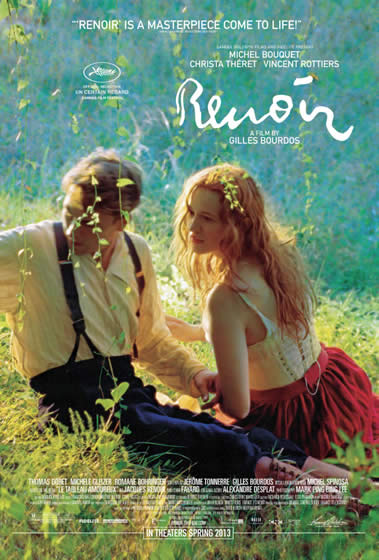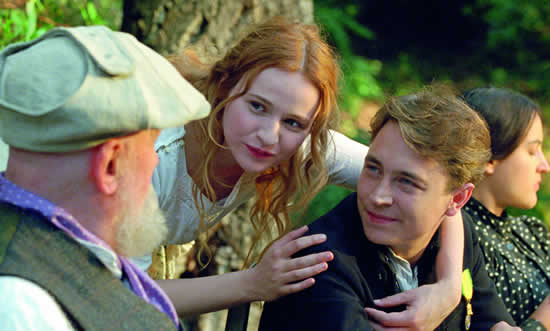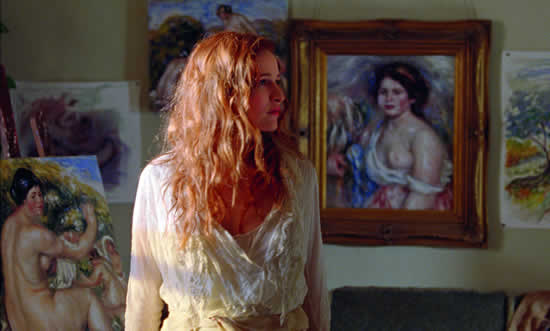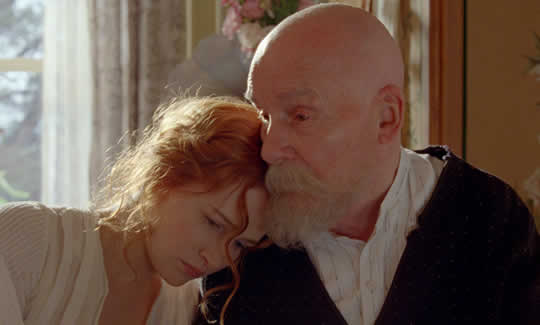 Set on the French Riviera in the summer of 1915, Gilles Bourdos’ lushly atmospheric drama RENOIR tells the story of celebrated Impressionist painter Pierre-Auguste Renoir, in declining health at age 74, and his middle son Jean, who returns home to convalesce after being wounded in World War I.
Set on the French Riviera in the summer of 1915, Gilles Bourdos’ lushly atmospheric drama RENOIR tells the story of celebrated Impressionist painter Pierre-Auguste Renoir, in declining health at age 74, and his middle son Jean, who returns home to convalesce after being wounded in World War I.
The elder Renoir is filled with a new, wholly unexpected energy when a young girl miraculously enters his world. Blazing with life, radiantly beautiful, Andrée will become his last model, and the wellspring of a remarkable rejuvenation. At the same time, Jean also falls under the spell of the free-spirited young Andrée. Their beautiful home and majestic countryside grounds reverberate with familial intrigue, as both Renoirs, père et fils, become smitten with the enchanting and headstrong young muse.
RENOIR locates a fascinating moment of change, one century’s way of thinking giving way to the next, and the passing of the torch from a great painter to the great filmmaker of such classics as Grand Illusion and Rules of the Game.
Here is CWB’s interviews with Gilles Bourdos, director of RENOIR and Christa Théret that has an amazing performance as Andrée.
Bijan Tehrani: RENOIR is a very unique film: you feel so close to the artist. How close is this story to the real life of Renoir and what was your approach as a filmmaker to make his life into a movie?
Gilles Bourdos: The storyline in its main lines, the characters, and the sequence of events are all true. Of course there is a part of fiction as well within a framework that was historically correct, on the relationships between the characters for example since there are no documents to relate all this.
BT: The visual style of RENOIR in many ways reminds us of Renoir’s paintings: not just the texture of the film, but also the drama and storyline. This is close to what we can imagine Renoir to do if he was a filmmaker…
GB: Thank you! I was never trying to reproduce Renoir’s paintings but I was so immersed in his work, his sense of color, his sensuality, his thoughts… that it probably came more from observation, from the sensations his work gave me rather than from an attempt to copy his paintings. I was also very inspired by Jean’s films, which were imbued by his father’s universe.
BT: The characters are very interesting and strong. In this type of films, often times everything is built around the main character but here Andrée and Renoir’s son are also portrayed precisely and they are as important as Renoir in the film. What was your purpose in doing that?
GB: I was never interested in doing a biopic on Renoir but I was interested in the situation of this trio. The film is very well balanced between these three characters. You are seeing a transmission from father to son and the means of transmission is the model in between them. It’s the transmission from father to son as well as the transmission from painting to cinema and she is the means by which it happens. It all takes place during a short period of time.
BT: Nature also seems to be an important element in RENOIR: the light, the element of water, the trees… Tell us a bit more about the treatment of nature in the film.
GB: For me the most important natural element was water because it is an essential element both in Auguste Renoir’s paintings and in his son Jean Renoir’s films: they almost capture the spirit of water, as opposed to stone or architecture. In fact, Renoir’s paintings are very fluid and they almost look like watercolors. As far as nature, I really singled out the nature locations with a great deal of care. The reason for this is that when you look at the very last paintings that he did, he is at that point moving away from the sensibility of the impressionist paintings, where they were reporting their impression of what they were seeing. Here in his last paintings, he was much closer to the actual bodies, to getting into the physical bodies of the figures he was painting. These bodies are within a very idealized type of nature, as though they were still alive but had already gone beyond and entered paradise.
 BT: The selection of the characters is amazing. How did you go about the casting of the film?
BT: The selection of the characters is amazing. How did you go about the casting of the film?
GB: The actor, who plays Auguste Renoir, Michel Bouquet, is an actor who is extremely well-known in France. He made his mark in many Chabrol films in the 60s and he is an icon of theater as well, he occupies a position in film maybe similar to the British actor John Gielgud, so he was an evident choice for me from the beginning. He embodied the idea of master to the younger actors who would play with him. For the other characters, I tried to be very close to the people they were representing. For Andrée for example, I needed an actress who had the kind of sensuality she had, the kind of beauty, the very pale skin that Renoir liked, but also the sort of insolence and energy that the real Andrée had, and I found this in Christa, who was 20 years old when she played this part. As for Jean Renoir’s role, it was very tricky because there are a lot of traps: not only is he a very famous director but he was also an actor in a number of his films, most notably in The Rules of the Game. And when we see him in Rules of the Game, he is already a bit old, 45 years old, he is bald and fat, and he was actually a bit of a bad actor… so what we tried to do rather was to observe the heroes he had created, who were a bit like his double, such as Jean Gabin in Grand Illusion.
BT: Thank you for your time. I wish you luck with your beautiful film in the united States.
GB: Thank you!
***
Bijan Tehrani: How were you first approached by Gilles Bourdos for acting in RENOIR and what was your first impression?
Christa Théret: I met Gilles in a cafe where he showed me the script. I was very moved by the story but I didn’t think my physique could fit. I am skinny, I am blonde, I didn’t think I looked in any way like a Renoir model. I gained some weight for the part and colored my hair, I went to see some of the early Renoir films in which the actual Andrée appears to gain an idea of the person she was. And she was a very thin energetic woman so I realized Renoir may have distorted her body when he was painting. I didn’t know anything about this character but I felt this film was an homage to her.
BT: This is a sophisticated part: an interesting and independent woman. How did you get to know the character and get into her psychology?
CT: The character of Andrée Heuschling is a very nuanced character. In a way, she is very naïve: for example when she first arrives at Renoir’s home, she doesn’t know who Auguste Renoir is. She has her own idea of what conditions she will accept for doing the job, and which ones she won’t. She also has a very fixed idea about going beyond her social class, and does not want to be depicted as her social class. In this sense, she is very avant-garde. I think the relationship she had with Jean Renoir was very complex. I went to see some of the early films he did with her, Nana, The Little Match Girl and I felt her to be someone full of energy and I was able to see what Jean saw  in her. In a sense, she’s a bit of an arriviste because she comes with big ambitions, wanting to be a movie star, but at the same time she is not an arriviste in a bad way because she is very sincere. She is very sincere in her interactions with Renoir the father and Renoir the son.
in her. In a sense, she’s a bit of an arriviste because she comes with big ambitions, wanting to be a movie star, but at the same time she is not an arriviste in a bad way because she is very sincere. She is very sincere in her interactions with Renoir the father and Renoir the son.
BT: How was your work with the Gilles Bourdos?
CT: It would depend on the scene but we always communicated a lot. We had discussed the character at length before the film. Sometimes I would suggest an approach to Gilles and it might coincide exactly with what he was thinking; other times we would look at an approach together. Working together with Michel Bouquet and Vincent Rottiers, we didn’t rehearse but people were very open to trying new things. The communication process with the director was very fluid.
BT: What is the next project you are working on?
CT: I am a little superstitious so I prefer not to say too much about it but there are two films that are in the process of getting financing and there are two that are ready, one is supposed to begin shooting in August.
BT: We wish you luck and success!
CT: Thank you very much.

